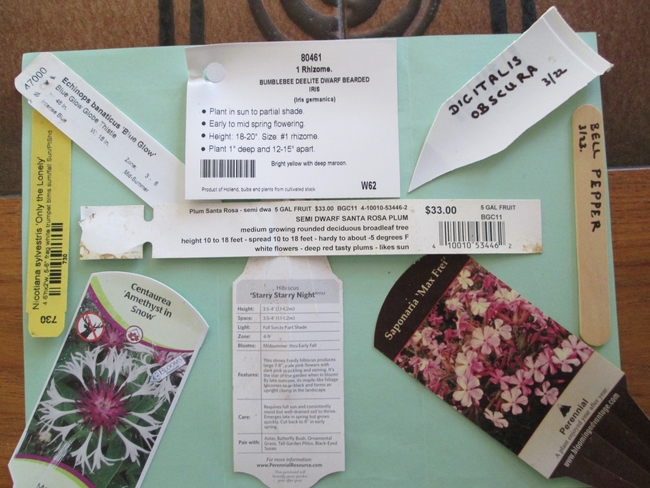It is important to keep plant labels, preferably inserting them next to where the plant was put. But failing that, at least keep the label in a safe spot – a box or envelope or suchlike so that it can readily be accessed for future reference.
As a Master Gardener it is often difficult to give advice on how to grow something when the owner has no idea as to what variety it is. A case in point was the “non-fruiting raspberries” that a grower was complaining about. She had been told that you cut all canes to the ground in spring, but she never had a raspberry to eat. I asked what variety they were but she had no idea as she had thrown away the labels, but then luckily recalled that, “It was something like Shortcake”. Without a label or a notion of which variety the plant was, helping to solve the problem relies on a fair measure of guesswork.
From her recollection, I knew immediately that her pruning regime was completely wrong. She had been cutting to ground level all the stems that would bear fruit that year because that particular variety is a floricane bearer, but it had erroneously been pruned as though it was a primocane bearer. Not all raspberries are the same!
Keep the labels of fruit trees that you plant, too. Moving into a house with an established garden, we became owners of a very old peach tree which gives wonderful crops of excellent-flavored peaches every year. The tree itself has many sun-scorched branches and is well on its way to dying. I should love to replace it with a younger version, but have so far not been able to identify which variety it is.
If you grow roses, before long many of the names will be forgotten and you may want more of the same variety, or like me want to make sure that you don't buy a “mistake” again! In this case it was one called 'Westerland' which has beautiful flowers but the most ferocious thorns making gardening around it a misery.
Fruit and vegetable plant varieties and cultivars are important since they provide differing flavors, sizes, hardiness, crop yields, and flowering times. We go to endless trouble to buy the right sort of car, or breed of dog, but many people buy an apple without realizing that it may need a special pollinator in order to set fruit, or buy an apricot that may be a variety that blooms so early that it will inevitably be frosted in or erratic climate.
Most labels will have vital information to help you decide whether your purchase is likely to ensure that you are planting “the right plant in the right place” and not putting a 50 foot tall tree under powerlines, planting a zone 8 plant in Mammoth Lakes, or buying an acid-loving plant for a garden with strongly alkaline soil.
When you have planted your new acquisition keep the label!
Then you will:
- Learn the correct name of the plant and remember it.
- Remember where you planted things that die down in the winter and so avoid planting something else on top of it. Especially important with bulbs.
- Be able to exactly replace it if it dies, or buy more of the same if it is a plant that you really like or does exceptionally well.
- Be able to look up further information regarding its care and special needs.
- Know for certain which tomato is which in a tray of seedlings so that you won't accidentally give away the one that you really, really wanted to try!
- Be able to leave instructions for a specific plant if someone else is caring for your garden or harvesting produce when you are on vacation.
- Accurately know the name of any seeds or bulbs that you save.
Labels come in all shapes and sizes but whereas those marking vegetables are only needed to last a season, long-term landscaping plants require more durable markers if they are to be of any use. For information and suggestions on materials to use check out the following website:
https://marylandgrows.umd.edu/2018/05/04/the-importance-of-being-labeled/
And one final thought: Unless you plan to check on them often, the place to keep plant labels is not on tree branches. They either blow away eventually, or if they are durable, may girdle branches in the future.
